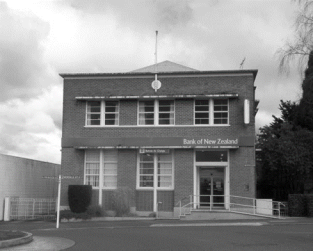HH-37: BNZ Bank - Putāruru

Date of Photograph: 11/11/2008
Location and Zoning Information | |
Address |
corner of Main Street, Princes Street, and Overdale Street. |
Current Owner |
Gocon Ltd |
Legal Description |
Pt Lots 28 + 29 DP14428 |
Zoning |
Town Centre Zone |
Valuation Number |
0541728000 |
Google Maps Link |
|
Architecture | |
Date of Construction |
1940s |
Materials |
The bank is two storied and features the banking facilities on the ground floor and the manager’s residence on the top floor. The manager ceased occupying the building in the late 1960’s. The BNZ design is typical of the interwar functionalist style: cubic massing, simple geometric shapes, free of non-functional ornaments, roof concealed by a parapet, metal framed ribbon windows, and cantilevered hoods over the openings. The manager’s house is not evident from the front façade. Domestic features associated with the residence are focused at the rear of the building. The manager’s garage is still located behind the building. |
Architecture/Engineer/Builder |
The bank has a strong architectural presence in Putāruru. The bank was designed in 1941 by Edgecumbe and White, a well known regional architectural firm that was located in Hamilton. The bank was remodelled in 1970 by White and MacDonald, Hamilton. The remodelling has had a nil to minor effect on the original exterior. The interior has been remodelled but the changes are not dramatic. (The building plans are stored at the bank) |
Condition |
The building is in excellent condition and in use as a BNZ bank. |
Original Site Recommendation |
|
Current Use |
BNZ bank. |
Statement of Significance | |
Criteria for Scheduling: 1, 3, 5, 6, 10, 11, and 12 1. Aspect of history - associated with business confidence in the timber industry and agriculture in the district. 3. Community association – associated with the economic growth of Putāruru into a town in the late 1930’s. Putāruru’s business community. 5. Symbolic - economic growth in the district 6. Educational Use – could be included as an item on a heritage trail. 10. Architectural - example of inter war functionalist style, designed by Edgecumbe and White (Hamilton). 11. Context cultural landscape/complex or group – anchors the commercial district of Putāruru. 12. Integrity – good condition/but altered (note: Previous Alterations notes: based on the architectural plans the central entry and architrave were moved to their current location, off centre, in 1970s. The entry was inserted in the opening occupied by windows and the window relocated to the central entry. Tile roof replaced by corrugated iron. Two of the three chimneys were removed. Interior was remodelled in the 1970s). District Plan RulesDemolition – DIS. Refer to HH-R3. Protection focus - 1, 3, 5, 6, 10, 11, and 12. Mitigate the effects of demolition by requiring the applicant to provide a Historical Building Documentation (HBD) which should include: the structure’s history, photographic documentation, and measurements of the item prior to removal. Alterations necessary for the primary purpose of improving structural performance, fire safety or physical access – CON -Refer to HH-R2. Other Additions/Alterations - DIS. Refer to HH-R3. Protection focus – 10. Effects can be mitigated/ remedied through a) an HBD (see mitigating the effects of demolition). b) Design Rules: The overall visual character/ shape of the original building should be identifiable. The addition should not dominate the existing building frontage on Main, Princes, and Overdale Streets or affect the cubic massing/shape, except at the rear of the building. New work should be restricted to the rear of the building and not be evident from the street/road frontage. Special elements that are associated with the rarity or architectural uniqueness or craftsmanship of the structure should be retained:
Other elements of the structure that should be retained are those elements associated with the structure’s historic character, use, rarity, landmark values, craftsmanship, etc. (i.e. façade, exterior walls, openings, chimney, landscape, and any other special elements identified in the HBD. c) Building Materials Rule: If repair of the building is proposed the materials used for the exterior walls and elements (i.e. windows, mullions, lentils, building base, and central entry surround) should be similar in type, dimensions and profile as the existing exterior fabric of the building. Repair of the Structure –DIS. Refer to Rule HH-R3. Protection focus – 10. a) Building Materials Rule: If repair of the building is proposed the materials used for the exterior walls and elements should be similar in type, dimensions and profile as the existing exterior fabric of the building. b) Design Rule: Repair or replication work should match the existing design, profile, and texture of the building elements. Reuse/Change of Use – DIS. Refer to Rule HH-R3. Protection focus - 1, 3, and 5. This is generally allowed and supported. Rationale for supporting reuse - history is an ongoing process. Reuse of historic structures in most instances ensures the structure is retained for future generations. Advice or Community concerns will be considered as well as economic viability, Occupational Safety and Health, zoning, etc. Disturbance of the site surface/earthworks – PER. Refer to HH-R1. Protection focus – 7. Existing plan rule relating to archaeological sites. This only applies if evidence is found to indicate that there was a pre-1900 site in the development zone. Internal Changes – PER. Refer to HH-R1 Protection focus – 10. Design Rule: Significant interior spaces and use areas should be identifiable. Historic elements should be retained. Remodelling is allowed but alterations must be documented (HBD). Relocation – DIS. Refer to Rule HH-R3. Protection focus – 1 and 3. Relocation may be necessary to preserve an item for future generations. Mitigate the effects by 1) Consulting with the local community and/ or consulting with Iwi or special interest groups, 2) Relocating to a similar setting, 3) Documenting (HBD). 4) Applying rules relating to archaeological sites. | |